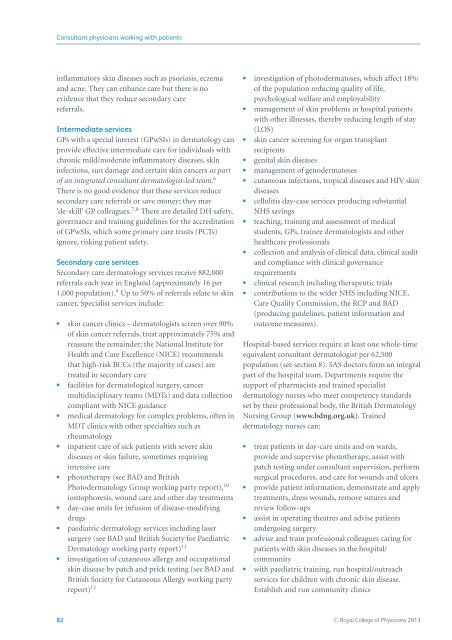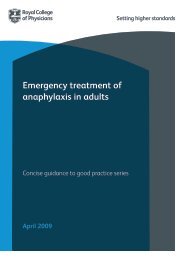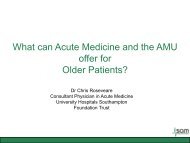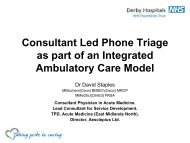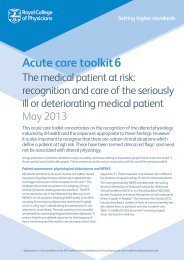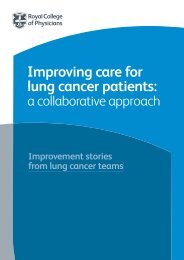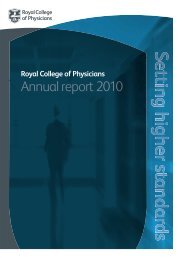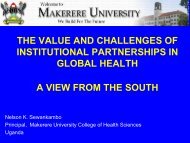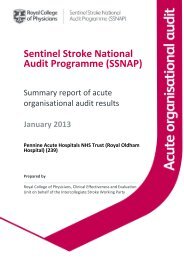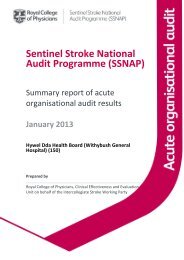Consultant physicians working with patients - Royal College of ...
Consultant physicians working with patients - Royal College of ...
Consultant physicians working with patients - Royal College of ...
Create successful ePaper yourself
Turn your PDF publications into a flip-book with our unique Google optimized e-Paper software.
<strong>Consultant</strong> <strong>physicians</strong> <strong>working</strong> <strong>with</strong> <strong>patients</strong>inflammatory skin diseases such as psoriasis, eczema investigation <strong>of</strong> photodermatoses, which affect 18%and acne. They can enhance care but there is no<strong>of</strong> the population reducing quality <strong>of</strong> life,evidence that they reduce secondary carepsychological welfare and employabilityreferrals. management <strong>of</strong> skin problems in hospital <strong>patients</strong><strong>with</strong> other illnesses, thereby reducing length <strong>of</strong> stayIntermediate services(LOS)GPs <strong>with</strong> a special interest (GPwSIs) in dermatology can skin cancer screening for organ transplantprovide effective intermediate care for individuals <strong>with</strong> recipientschronic mild/moderate inflammatory diseases, skin genital skin diseasesinfections, sun damage and certain skin cancers as part management <strong>of</strong> genodermatoses<strong>of</strong> an integrated consultant dermatologist-led team. 6 cutaneous infections, tropical diseases and HIV skinThere is no good evidence that these services reduce diseasessecondary care referrals or save money; they may cellulitis day-case services producing substantial‘de-skill’ GP colleagues. 7,8 There are detailed DH safety, NHS savingsgovernance and training guidelines for the accreditation teaching, training and assessment <strong>of</strong> medical<strong>of</strong> GPwSIs, which some primary care trusts (PCTs) students, GPs, trainee dermatologists and otherignore, risking patient safety.healthcare pr<strong>of</strong>essionals collection and analysis <strong>of</strong> clinical data, clinical auditSecondary care servicesand compliance <strong>with</strong> clinical governanceSecondary care dermatology services receive 882,000 requirementsreferrals each year in England (approximately 16 per clinical research including therapeutic trials1,000 population). 9 Up to 50% <strong>of</strong> referrals relate to skin contributions to the wider NHS including NICE,cancer. Specialist services include:Care Quality Commission, the RCP and BAD(producing guidelines, patient information and skin cancer clinics – dermatologists screen over 90% outcome measures).<strong>of</strong> skin cancer referrals, treat approximately 75% andreassure the remainder; the National Institute for Hospital-based services require at least one whole-timeHealth and Care Excellence (NICE) recommends equivalent consultant dermatologist per 62,500that high-risk BCCs (the majority <strong>of</strong> cases) are population (see section 8). SAS doctors form an integraltreated in secondary carepart <strong>of</strong> the hospital team. Departments require the facilities for dermatological surgery, cancersupport <strong>of</strong> pharmacists and trained specialistmultidisciplinary teams (MDTs) and data collection dermatology nurses who meet competency standardscompliant <strong>with</strong> NICE guidanceset by their pr<strong>of</strong>essional body, the British Dermatology medical dermatology for complex problems, <strong>of</strong>ten in Nursing Group (www.bdng.org.uk).TrainedMDT clinics <strong>with</strong> other specialties such asdermatology nurses can:rheumatology inpatient care <strong>of</strong> sick <strong>patients</strong> <strong>with</strong> severe skin treat <strong>patients</strong> in day-care units and on wards,diseases or skin failure, sometimes requiringprovide and supervise phototherapy, assist <strong>with</strong>intensive carepatch testing under consultant supervision, perform phototherapy (see BAD and Britishsurgical procedures, and care for wounds and ulcersPhotodermatology Group <strong>working</strong> party report), 10 provide patient information, demonstrate and applyiontophoresis, wound care and other day treatments treatments, dress wounds, remove sutures and day-case units for infusion <strong>of</strong> disease-modifying review follow-upsdrugs assist in operating theatres and advise <strong>patients</strong> paediatric dermatology services including laserundergoing surgerysurgery (see BAD and British Society for Paediatric advise and train pr<strong>of</strong>essional colleagues caring forDermatology <strong>working</strong> party report) 11<strong>patients</strong> <strong>with</strong> skin diseases in the hospital/ investigation <strong>of</strong> cutaneous allergy and occupational communityskin disease by patch and prick testing (see BAD and <strong>with</strong> paediatric training, run hospital/outreachBritish Society for Cutaneous Allergy <strong>working</strong> party services for children <strong>with</strong> chronic skin disease.report) 12 Establish and run community clinics82 C○ <strong>Royal</strong> <strong>College</strong> <strong>of</strong> Physicians 2013


